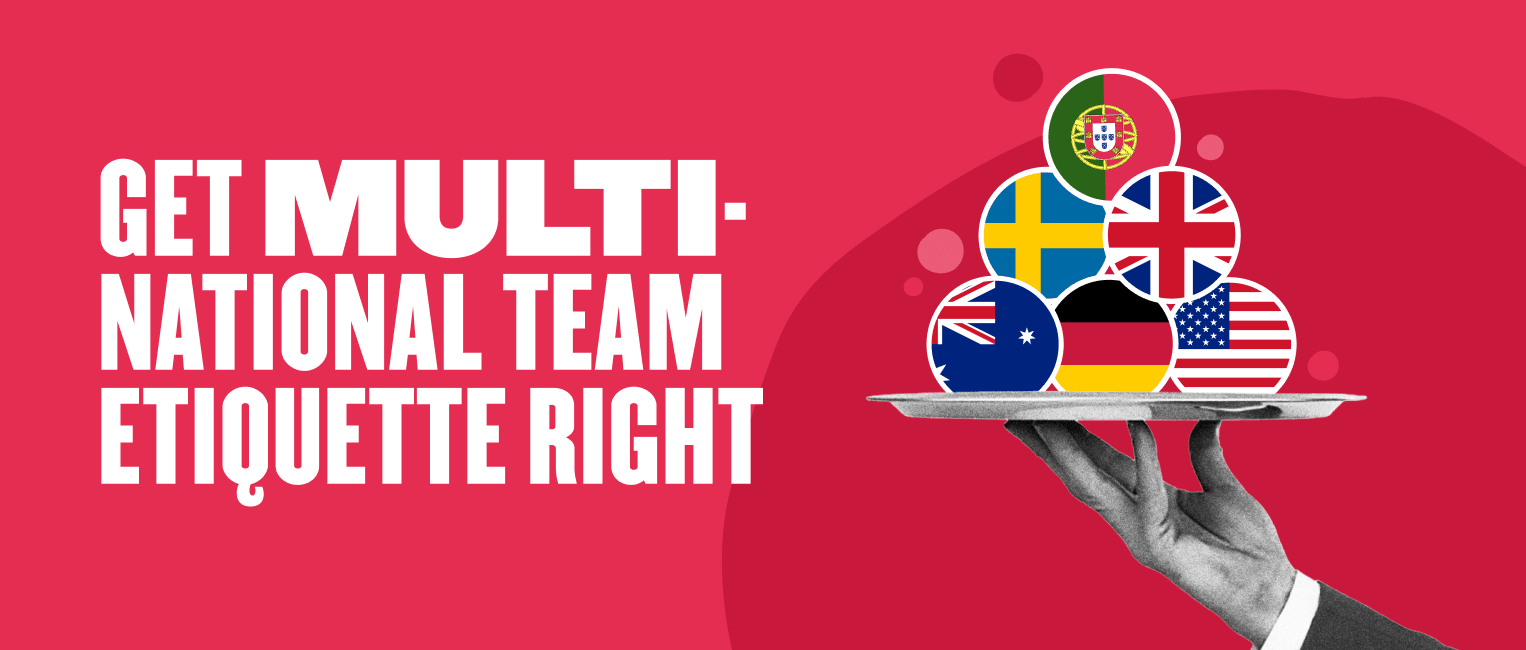How many people work remotely at your company? Across how many time zones?
In recent years, most companies have seen a real boom in the number of people working remotely. As a result, keeping your remote employees connected and forging great relationships between them have become new and pressing challenges for HR leaders and team managers.
People around the world interact differently—even when speaking the same language—and the smallest unintentional difference in mannerisms or speech can easily cause problems. This kind of challenge is something companies with multi-national, remote teams must face and navigate every day.
In this article, we’re going to explore how you can best prepare your teams for the potential pitfalls of remote work etiquette as your company grows and diversifies.
Challenge #1: Keeping things “on time”
Famously, “on time” has many different meanings around the world—and this can easily cause frustration or embarrassment at work.
For example, a meeting planned for 9:00 am in Germany or Japan will most likely begin promptly at 9:00 am. In the US, the same meeting might not get going until “a little late” at 9:05 am or so. On the other hand, in Israeli and other Middle Eastern cultures, 9:15 am would still legitimately be considered “on time.”
It’s easy to see how conflicting time etiquette approaches can trigger remote team members‘ interpersonal conflicts. Helping them understand and navigate each other’s expectations is key to managing healthy team relationships and ensuring projects run smoothly.
Challenge #2: Dressing your best
Professional dress codes are another potential minefield for multi-national teams—even when working remotely.
At one extreme, people in Dubai or China would likely dress formally and modestly at work, with conservative styles and covered skin. Argentinian dress code is similarly formal: Men are expected to wear neutral or dark colors while women are expected to wear a variety of styles and more colorful clothes. On the other hand, Australia is famously casual and largely excludes ties from professional wear.
In the UK or US, dress codes can be a bit trickier. They are likely to vary between different companies, with people also smartening up for certain occasions, such as a customer or external meeting or key event. In the US, variations even exist between coastlines. The east coast’s relative formality at work often clashes with the laidback approach of those on the west coast.
Clearly, what’s considered ‘formal’ in one culture might barely pass for casual home wear in another. Introducing each of your teams to their multi-national colleagues’ expectations is essential to ensuring understanding and more honest and open communication between them.
Challenge #3: Watching your tongue
Language and humor are other major differentiators between global cultures.
In Western countries, people regard a sense of humor as an overwhelmingly positive trait. Western culture has embraced humor for centuries, and it’s strongly associated with positivity. In fact, Westerners typically view humorous people as more attractive, motivating, creative, and capable.
In the East, people value humor far less. In China, for example, people do not tend to see humor as a desirable personality trait and may feel uncomfortable when they meet with Western colleagues’ extensive use of humor.
At the same time, comedic tastes and professional language choices vary widely. Whether it’s the Scandinavian dark sense of humor, the British passion for puns and wordplay, or the Korean love for funny voices, people are simply brought up to laugh at different things.
It’s important to remember that what might be hilarious in one culture might be less funny or even offensive in another, with family, politics, and religion, particularly sensitive areas. Checking the language you and your teams use regularly is crucial to avoid unintended offense.
Challenge #4: Differing approaches to DEI&B
Appropriate approaches to diversity, equity, inclusion, and belonging (DEI&B) also vary between cultures. In countries like the US, there is a strong progressive push to discuss race, ethnicity, and gender differences. It’s essential to be mindful that this may not be the case in other parts of the world.
Effective DEI&B training that focuses on language choices and the productivity spikes that diversity gives teams can go a long way to spreading awareness of potential sensitivities. Most importantly, it can help your teams treat each other appropriately.
Effective DEI&B metrics can help measure your progress as you adopt a policy of slow but consistent growth.
Recommended For Further Reading
Challenge #5: Saying a proper goodbye
The end of an interaction is typically the impression that lasts. That makes the way you end meetings and discussions important, especially when dealing with remote global teams over a video call.
If you’re letting go of a remote employee, it’s important to prepare thoroughly. Keep your communication clear and concise, focus on the meeting, and set up a follow-up so they can ask questions they may think of after the call.
Communication is at the heart of good etiquette
Managing remote teams with different cultural expectations ultimately comes down to identifying and preparing for the challenges you’re likely to face. By sharing the most common pitfalls with managers and their team members, you can give them a chance to ask questions of one another. Team members will also become conscious of how certain behaviors, mannerisms, and ways of speaking may appear to their colleagues around the world.
Good communication is the key to building a healthy and mutually supportive culture where international colleagues can work well with their globally dispersed teammates.


